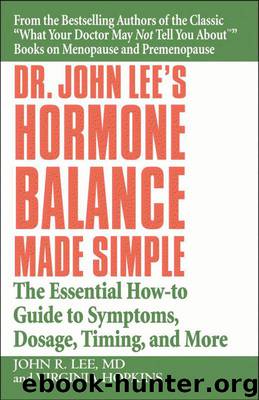Dr. John Lee's Hormone Balance Made Simple: The Essential How-to Guide to Symptoms, Dosage, Timing, and More by John R. Lee & Virginia Hopkins

Author:John R. Lee & Virginia Hopkins [Lee, John R.]
Language: eng
Format: epub
Tags: HEA024000
ISBN: 9780446554510
Publisher: Grand Central Publishing
Published: 2008-12-14T00:00:00+00:00
What Is Progesterone?
Progesterone is a steroid hormone made by the ovaries when you ovulate (release an egg) in the middle of your menstrual cycle. It’s also made in smaller amounts by the adrenal glands, and in even smaller amounts by some nerve cells. Progesterone is manufactured in the body from a steroid hormone called pregnenolone and is a precursor to most of the other steroid hormones, including cortisol, androstenedione, the estrogens, and testosterone, meaning that the body manufactures most of the other steroid hormones from progesterone. However, if you use supplemental progesterone, it will not raise your levels of the other hormones—that conversion apparently takes place prior to progesterone’s arrival in the bloodstream.
A woman with normal menstrual cycles produces 20 to 30 mg of progesterone daily from the middle to the end of her menstrual cycle. That’s why the goal in hormone replacement is to use that dose of progesterone.
Menstrual Cycle
One Normal Cycle = 18 to 32 days
Period Day 1____Æ ____Ovulation_____Æ _____Period Day 1
Estrogen Progesterone Estrogen and
rising rising progesterone falling
Progesterone’s most important role is to balance or oppose the effects of estrogen. By itself, estrogen creates a strong risk for breast cancer and reproductive cancers, as well as a long list of other symptoms (see chapter 7 for details). Progesterone also stimulates bone building and thus helps protect against osteoporosis. (Estrogen also plays an important role in bone health by slowing bone loss.)
Estrogen levels drop only about 60 percent at menopause, which is just enough to stop the menstrual cycle. But progesterone levels may drop to near zero in some women.
Download
This site does not store any files on its server. We only index and link to content provided by other sites. Please contact the content providers to delete copyright contents if any and email us, we'll remove relevant links or contents immediately.
Men In Love by Nancy Friday(5157)
Everything Happens for a Reason by Kate Bowler(4679)
The Immortal Life of Henrietta Lacks by Rebecca Skloot(4526)
Why We Sleep by Matthew Walker(4361)
The Sports Rules Book by Human Kinetics(4295)
Not a Diet Book by James Smith(3336)
The Emperor of All Maladies: A Biography of Cancer by Siddhartha Mukherjee(3068)
Sapiens and Homo Deus by Yuval Noah Harari(2987)
Day by Elie Wiesel(2720)
Angels in America by Tony Kushner(2596)
A Burst of Light by Audre Lorde(2546)
Endless Forms Most Beautiful by Sean B. Carroll(2431)
Hashimoto's Protocol by Izabella Wentz PharmD(2331)
Dirty Genes by Ben Lynch(2272)
Reservoir 13 by Jon McGregor(2242)
Wonder by R J Palacio(2140)
And the Band Played On by Randy Shilts(2129)
The Immune System Recovery Plan by Susan Blum(2030)
Stretching to Stay Young by Jessica Matthews(2001)
